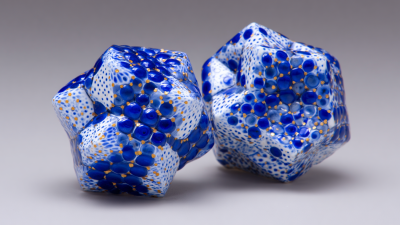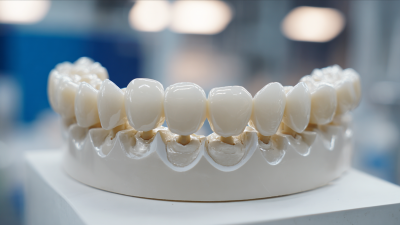Leave Your Message
 Zirconia ceramic has emerged as a groundbreaking material in modern dentistry, offering numerous advantages that enhance both function and aesthetics. According to a report by the American Dental Association, the use of zirconia-based restorations has significantly increased over the past decade, now representing approximately 30% of all dental crown materials used in clinical practice. This surge in popularity can be attributed to zirconia's remarkable strength and biocompatibility, which allow for durable restorations that closely mimic natural tooth color and translucency.
Zirconia ceramic has emerged as a groundbreaking material in modern dentistry, offering numerous advantages that enhance both function and aesthetics. According to a report by the American Dental Association, the use of zirconia-based restorations has significantly increased over the past decade, now representing approximately 30% of all dental crown materials used in clinical practice. This surge in popularity can be attributed to zirconia's remarkable strength and biocompatibility, which allow for durable restorations that closely mimic natural tooth color and translucency.
Furthermore, studies published in the Journal of Dentistry highlight that zirconia ceramic exhibits superior wear resistance and lower plaque accumulation compared to traditional ceramics, making it an ideal choice for long-term dental solutions. Given these compelling benefits, this article will explore the multifaceted applications of zirconia ceramic, not only within the realm of dentistry but also in various industrial sectors, thereby illustrating its potential as a versatile and valuable material.
Zirconia ceramic has emerged as a game-changer in modern dentistry, thanks to its unique set of properties that significantly enhance various dental applications. One of the most compelling characteristics is its high strength and fracture toughness. According to a study published in the Journal of Dental Research, zirconia exhibits a flexural strength of approximately 1,200 MPa, which is nearly twice that of traditional ceramics. This exceptional strength allows for the creation of more durable dental restorations, reducing the risk of fracture and thereby extending the lifespan of dental prosthetics.
In addition to strength, zirconia's biocompatibility is a crucial factor in its adoption within dental practices. Research from the International Journal of Prosthodontics indicates that zirconia has an excellent tissue response, meaning that it does not elicit adverse reactions from the body, making it suitable for use in implants and bridges. Moreover, its aesthetic qualities cannot be overlooked; zirconia can be easily stained or layered to mimic the translucency of natural teeth. Reports show that 80% of dental professionals believe that zirconia offers superior aesthetics compared to metal ceramics, highlighting its dual role in function and beauty. These key properties not only enhance the effectiveness of dental applications but also resonate with patients' desires for long-lasting and visually appealing results.
Zirconia ceramics have revolutionized restorative dentistry with their unique properties that enhance both aesthetics and functionality. The recent advancements in glazing techniques spotlight their importance in improving the surface roughness and hardness of zirconia restorations.
Glazing not only provides a smooth, glassy finish that enhances the visual appeal of prosthetics but also contributes to their overall durability, making them a preferred choice for various dental applications.
Furthermore, the innovation of 3D printing technology has streamlined the manufacturing process of zirconia restorations, significantly reducing processing times while maintaining high quality. This technique allows for the customization of dental restorations, catering to the specific needs of patients. As research continues to explore and refine the integration of zirconia ceramics in dentistry, techniques such as enhanced bonding strategies are emerging, addressing challenges related to adhesion and ensuring the longevity of these restorations. The evolution of zirconia ceramics in restorative practices marks a significant shift towards more efficient, durable, and aesthetically pleasing dental solutions.
Zirconia ceramic has emerged as a revolutionary material in modern dentistry, particularly due to its numerous advantages over traditional dental materials. One of the primary benefits is its exceptional strength and durability, making it an ideal choice for crowns, bridges, and dental implants. Unlike porcelain, which can chip or crack under pressure, zirconia is known for its resistance to fracture. This intrinsic toughness not only enhances the longevity of dental restorations but also provides patients with greater peace of mind.
Another significant advantage of zirconia is its biocompatibility. Being a metal-free material, zirconia eliminates concerns related to allergies and sensitivities that some patients might experience with metals. Additionally, zirconia's natural-looking translucency closely mimics that of natural teeth, allowing for superior aesthetic results. This is particularly beneficial in cosmetic dentistry, where appearance is crucial.
Tip: When considering zirconia for dental treatments, consult your dentist about the specific benefits it can offer for your individual needs. Also, ensure that you choose a skilled dental professional experienced in working with zirconia to maximize the potential of this advanced material.
Moreover, the ease of digital fabrication with zirconia reduces production time and enhances precision in restorations. This makes it a favored choice for dental laboratories, streamlining the workflow while maintaining high standards of quality.
Tip: If you’re in need of dental restorations, ask your dentist if they use CAD/CAM technology for zirconia fabrications to ensure a custom fit and optimal performance.
Zirconia ceramic is rapidly transforming the landscape of modern dentistry, offering remarkable advantages such as superior strength, biocompatibility, and aesthetic appeal. As technology develops, the potential applications of zirconia expand beyond dental restorations. Future innovations are poised to enhance its integration in various fields, including implantology and orthodontics, where the material’s durability and versatility can lead to revolutionary advancements in patient care.
Research is underway to further improve the properties of zirconia, such as its translucency and resistance to wear. Enhancements in processing techniques may allow for the creation of even thinner and more flexible restorations. Furthermore, the exploration of zirconia in areas like orthopedics and prosthetics presents exciting possibilities, as its low thermal conductivity and corrosion resistance make it an ideal candidate for medical implants that require long-term stability and are less susceptible to rejection by the body. The intersection of zirconia ceramic with emerging technologies surely paves the way for innovative approaches to healthcare and beyond.
| Application Area | Benefits | Future Innovations |
|---|---|---|
| Dentistry | High aesthetics, Biocompatibility, Excellent durability | 3D printing technologies, Customized implants |
| Orthopedics | Enhanced strength, Reduced wear | Bioactive coatings, Smart materials |
| Aesthetic Applications | Natural appearance, Stain resistance | Color-changing properties, Improved translucency |
| Dental Prosthetics | Long-lasting, Easy to shape | Advanced CAD/CAM solutions, Integration with digital workflows |
| Other Medical Applications | Versatile use, Compatibility with various tissues | Innovative delivery systems, Regenerative medicine |
Zirconia ceramics have emerged as a revolutionary material in modern dentistry, particularly for dental implants and prosthetics. Their exceptional durability, biocompatibility, and aesthetic appeal make them a preferred choice for patients seeking high-quality dental treatments. A key aspect of zirconia dental products is their longevity, which is supported by recent industry advancements, including lifetime warranties that enhance patient confidence and commitment to treatment.
The introduction of lifetime warranties for zirconia arches signifies a notable shift in how dental practices address patient concerns about the longevity and maintenance of these products. This offering not only assures patients of the quality and durability of their zirconia implants but also encourages them to prioritize regular dental check-ups and maintenance. With proper care, zirconia products can provide lasting solutions, reducing the need for frequent replacements and ensuring that patients enjoy the benefits of their investment over time.






